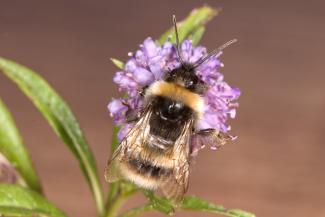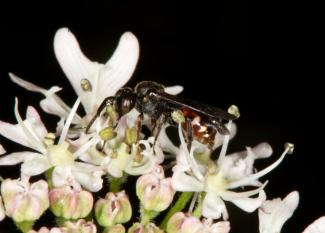PoMS down the microscope
PoMS has represented a strong partnership between scientists, field surveyors and specialists, both volunteer and professional, since its design and testing phase in 2015. When it comes to identifying the bees and hoverflies from pan trap surveys, we work with a handful of experienced taxonomists through Hymettus Ltd, who take on the painstaking job of turning all our sodden specimens into real data in the space of a few weeks. Below we hear from one of them about their experience of “PoMS down the microscope”.
Much of my life has been spent as an environmental scientist and volunteer naturalist in equal measure. The former has left me with a healthy respect for accurate working and the latter led me to take on the identification of wild bees and other Hymenoptera. Along the way, I’ve experienced the gap, sometimes gulf, between professionals and volunteer specialists, both as a social study and in conservation work. Imagine my pleasure and satisfaction to be invited to participate in a project that embraces – with exceptional success – a blended team of scientists, field staff and specialists, both volunteer and professional. This is PoMS.
Over many years I have used water-filled pan traps for sampling invertebrates during site surveys, as well as exploiting their suitability for replicate and repeatable point samples. So I’m no stranger to trying to identify sad-looking drenched and jostled bees. As I sit at my microscope, working my way through bags of PoMS bees from all over the country, I feel a strong affinity with the dedicated field workers, perhaps volunteering or working alone, and all delivering the PoMS methodology. Furthermore, I look at the on-line location maps and imagine some of the beautiful places that have been enjoyed while operating the pans.
Highlights for me have been the bees that I’d not keyed before and only seen in collections, such as the Downland Furrow Bee (Halictus eurygnathus - second photo above) and the Flat-ridged Nomad Bee (Nomada obtusifrons). And with me being a southerner, meeting up with those Scottish pals who are not so common south of the border – Broken-belted Bumblebee (Bombus soroeensis - first photo above) and the Heath Bumblebee (B. jonellus).
Working through hundreds of British bees has been, for me, more than a service to the PoMS project, it has also been a great learning opportunity to see regional variations and the developmental peculiarities that the natural world can come up with, especially those that confound the identification books. Not just the melanic, bleached and extremes of large or small, but also malformations that have left me grasping for the clues for which Sherlock Holmes would have been a useful buddy. For example, there are the confusing female-male gynandromorphs and – although not a bee – I once had a sawfly with six legs and seven feet!
Many thanks to Ivan Wright and Mike Edwards, bee specialists for Hymettus, for contributing text and photos respectively




